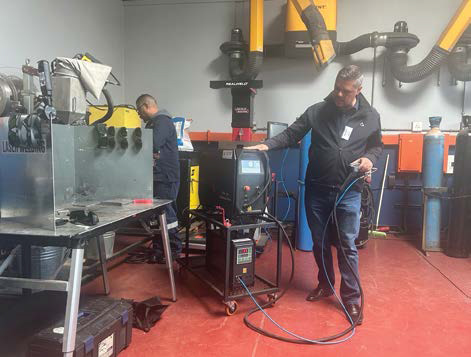Sassda hosted an enlightening Laser Welding Workshop at the Southern African Institute of Welding (SAIW) last year, bringing together experts, industry professionals, and welding enthusiasts to explore cutting-edge advancements in laser welding technology.
Click to download and read pdf

Factory Smart’s John Owen Welgemoed underscored the efficiency of laser welding: “With laser welding, you can work two to three times faster than conventional methods, depending on the material.”
Through insightful presentations and hands-on demonstrations, a Laser Welding Workshop held at the SAIW last year highlighted how laser welding is set to revolutionise industries ranging from manufacturing to aerospace.
Laser welding, though a relatively recent development, has made remarkable strides since its inception in 1960. Rob Lawrence, one of the key speakers at the workshop, emphasised how quickly this technology has evolved. “Laser welding technology was only invented in 1966, making it relatively new. Over time, the technology has continued to improve. Torches are becoming smaller, machines are getting lighter, and the need for water-cooled heavy systems has disappeared.”
From its initial applications using ruby lasers to today’s advanced systems, laser welding has come a long way. Lawrence highlighted futuristic advancements, such as a flexible torch head, which provides more flexibility in welding applications. This continuous evolution makes laser welding not just a current industry trend but a technology that promises long-term growth and innovation.
Lawrence also emphasised the potential business opportunities laser welding presents for South African industries. This against the backdrop of significant growth projected for the global laser market. “The laser cleaning market alone was valued at US$685-million in 2022, with rapid expansion expected. As laser welding becomes more widespread, it will revolutionise various sectors, offering a chance for South African businesses to stay competitive in the global market,” stated Lawrence.
One of the major topics discussed at the workshop was the numerous benefits laser welding offers over traditional welding methods. Factory Smart’s John Owen Welgemoed underscored the efficiency of laser welding: “With laser welding, you can work two to three times faster than conventional methods, depending on the material. It produces neat, precise welds with very small heat-affected zones, especially on stainless steel. This significantly reduces distortion and resolves many manufacturing challenges.”
Welgemoed shared examples from his own experience, including a customer in Paarl who had drastically reduced production times. “A job that previously took him eight hours to complete with traditional welding, now takes just two hours using laser welding.
“This improvement has opened doors for more work, new projects, and even the possibility of exporting. By speeding up production times and minimising finishing work, businesses can save costs on labour and materials, making laser welding a more efficient and economical choice,” he explained.
Overall, Welgemoed explained: “Laser welding will drastically improve production efficiency and reduce labour costs. The future of manufacturing will be shaped by this technology. By adopting laser welding, businesses can expect to increase their output and reduce waste, while also contributing to the overall industrial growth of the country.
Laser welding’s versatility was another highlight of the workshop. Whether it’s used for cutting-edge aerospace components or intricate jewellery making, this technology is applicable across numerous industries.
One particularly compelling demonstration at the event showcased the ability of laser welders to work with tricky materials such as aluminium and stainless steel, delivering high-quality results.
“These materials can be tricky no matter the method, but with a laser welder, it’s easier. You simply place the torch, and the wire pushes the weld along smoothly. With a 1.5 kW laser, you can achieve three to four millimetres of penetration,” Welgemoed pointed out.
In addition, laser applications go beyond welding. The technology is being used for laser cleaning, laser bending, and even laser dentistry, showcasing its incredible range. Lawrence pointed out that industries such as aerospace and food processing are set to benefit greatly from these advancements.
The need for training and certification
As laser welding technology continues to advance, the importance of proper training and certification cannot be overstated. SAIW’s Confidence Lekoane, announced that the institute will be introducing a laser welding courses starting in 2025 to meet the rising demand for skilled laser welders.
“Our new course will introduce laser welding, covering the fundamentals of the process, the equipment used, and essential safety precautions. Participants will learn about quality control, how to eliminate and prevent defects, and they will get hands-on training,” she said.
Lekoane added that given the precision and high-energy output of laser welding equipment, safety protocols are a top priority. Factories using laser systems must have specialised safety zones, and operators need to be well-trained to prevent accidents. “For instance, improper handling of a laser cleaning system could result in unintended damage to the surrounding area, making education a crucial component of laser technology adoption,” she said.
The Laser Welding Workshop hosted by Sassda at the SAIW Campus was a resounding success, providing participants with valuable insights into the future of laser welding technology. As Lawrence, Welgemoed, and Lekoane all emphasised, laser welding is not only more efficient and versatile than traditional methods but also easier to learn and implement. This makes it an attractive option for industries looking to modernise.













